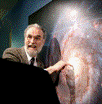Department of Physics and Astronomy: Publications and Other Research
Date of this Version
11-9-2006
Abstract
We present the results of an analysis of line profiles of high- and low-ionization broad emission lines in 8 AGNs observed by the Hubble Space Telescope. We derive the physical conditions in the gas as a function of velocity. We find no evidence for a separate intermediate line region. For the broad line region as a whole we find a major contradiction between the velocity dependencies of conditions deduced from the major high-ionization lines and those deduced from the hydrogen lines alone if they are assumed to come from the same gas clouds. The hydrogen lines imply that the density decreases with decreasing velocity and the ionizing flux on the gas also decreases with decreasing velocity, while both the density and the ionizing flux deduced from the high-ionization lines are independent of the velocity. We believe that there are two kinematically distinct components of the BLR. The change in ionizing flux implied by the hydrogen lines is consistent with virialization of the motions of the gas producing the low-ionization lines and with the flux falling off as the inverse square of the distance from the central engine. The density of the gas must therefore increase towards the central engine. The velocity-independence of conditions inferred from the high-ionization lines can only be explained if the velocity of the high-ionization gas is independent of distance from the central source. This implies that the motions of this gas cannot be gravity dominated and arise instead in a radiatively-driven outflow.


Comments
“Submitted to The Astrophysical Journal 2006; online at http://galileo.apo.nmsu.edu/~snedden/papers/hi_low_submitted.pdf.